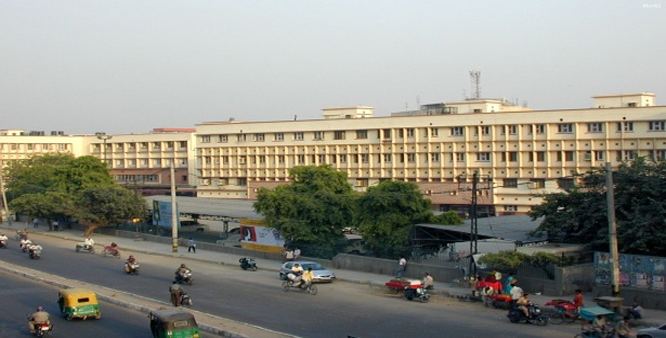 | ||
Old delhi tis hazari court and metro station
Tis Hazari is a neighbourhood in Old Delhi, India just south of the Northern Ridge. It is the location of the Tis Hazari Courts Complex which was inaugurated on 19 March 1958 by Chief Justice Mr. A. N. Bhandari of the then Punjab High Court. It is one of the five District Courts that function under the Delhi High Court, and continues to be the principal Court building in state of Delhi.
Contents
- Old delhi tis hazari court and metro station
- Map of Tis Hazari New Delhi Delhi
- History
- Tis Hazari Court
- Transport
- References
Map of Tis Hazari, New Delhi, Delhi
History
The place gets its name from a force of 30,000 Sikhs, which encamped here under military general Baghel Singh Dhaliwal in 1783, prior to attacking Delhi. Under the command of Baghel Singh Dhaliwal and other leading warriors crossed the Yamuna and captured Saharanpur. They overran the territory of Najib ud-Daulah, the Ruhila chief, acquiring from him a tribute of eleven lakh of rupees (INR 1,100,000). In April Baghel Singh Dhaliwal with two other sardars (Rai Singh Bhangi and Tara Singh Ghaiba) crossed the Yamuna to occupy that country, which was then ruled by Zabita Khan, who was the son and successor of Najib ud-Daulah. Zabita Khan in desperation offered Baghel Singh Dhaliwal large sums of money and proposed an alliance to jointly plunder the crown lands. Sardar Baghel Singh Dhaliwal set up an octroi-post near Sabzi Mandi to collect the tax on the goods imported into the city to finance the search and the construction of the Sikh Temples. (He did not want to use the cash received from the Government Treasury for this purpose, and most of that was handed out to the needy and poor. He often distributed sweetmeats bought out of this government gift to the congregationalists at the place which is now known as the Pul Mithai.)
On 11 March 1783, when the Sikhs entered the Red Fort in Delhi and occupied the Diwani-Am, the Mughal emperor Shah Alam II made a settlement with them agreeing to allow Baghel Singh Dhaliwal to raise gurdwaras on Sikh historical sites in the city and receive six annas in a rupee (37.5%) of all the octroi duties in the capital
Tis Hazari Court
The Tis Hazari Courts Building was inaugurated in 1958, though in the earlier days the Tis Hazari was the only court complex in the whole of the Delhi as the District Level Court Complex--- But at Present Tis Hazari Houses only Courts having their jurisdiction over Central Delhi, West Delhi. Courts having their jurisdiction upon other parts of Delhi have been gradually shifted to other court complexes which have come up in various parts of Delhi like in 2006 Rohini Court complex was established which has courts having jurisdiction over North-West Delhi and Outer Delhi.
The District Courts (from which both civil and criminal cases were transferred) branched out from the original Tis hazari Courts are : District Courts at Patiala House (New Delhi District), Karkarduma (East Delhi District), Rohini (North & West District), Dwarka (South West District) and Saket (South District). Saket Court Complex started functioning with effect from Saturday, 28 August 2010. The Work of Civil and Criminal cases relating to South Civil District and South and South East Police Districts earlier looked after at Patiala House Courts Complex is now taken up with effect from the functioning of the courts of the respective districts at the new court complex at Saket.
The Chief Metropolitan Magistrate [CMM] of entire Capital Region Delhi Presides over its Court in Tis Hazari Courts Complex.
Transport
The area is serviced by the Tis Hazari station on the Red Line of the Delhi Metro. Besides the Metro connections, Tis Hazari District Court is well connected through a series of "Destination" Bus services run by the Delhi Bar Association from Karkardooma Court, Patiala House Court, Delhi High Court and Supreme Court. One can otherwise avail other local buses with the major Bus terminal / destination namely ISBT and the nearby Mori Gate bus stop.
